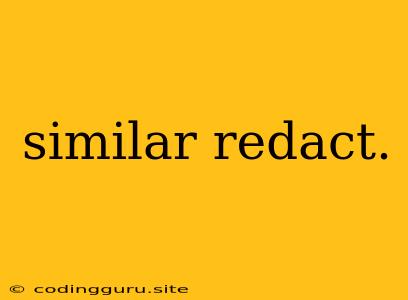Similar to Redact: Exploring Data Masking Techniques
Redaction, the process of concealing sensitive information within a document or dataset, is a crucial aspect of data privacy and security. It is often used to protect personally identifiable information (PII) and other confidential data from unauthorized access. While redaction is a common practice, there are various techniques similar to redaction that offer alternative approaches to data masking.
What is Redaction and Why is it Used?
Redaction is a data masking technique that involves replacing sensitive information with a placeholder or concealing it entirely. It is commonly employed in scenarios where:
- Protecting Privacy: Redaction is crucial for protecting individuals' privacy by preventing the disclosure of PII like names, addresses, and social security numbers.
- Compliance with Regulations: Various regulations, such as GDPR and HIPAA, require organizations to protect sensitive data, making redaction a vital compliance measure.
- Protecting Intellectual Property: Companies use redaction to safeguard confidential information such as trade secrets or sensitive business data.
Redaction Techniques: Common Approaches
There are numerous ways to redact data, each with its own benefits and drawbacks. Some common redaction techniques include:
- Blacking Out: This involves completely obscuring the sensitive information using a black box or a solid color.
- Replacement with Placeholder: Sensitive data is replaced with a generic placeholder, such as "XXXX" or "REDACTED".
- Data Transformation: Applying mathematical transformations to the data to make it unreadable while preserving the underlying structure.
- Hashing: Replacing sensitive information with a one-way hash function, ensuring that the original data cannot be recovered.
Similar Techniques to Redaction: Alternatives for Data Masking
While redaction is a well-established technique, there are several similar approaches that can achieve data masking effectively:
1. Data Subsetting:
- Concept: This technique involves selecting and displaying only a subset of the data, excluding the sensitive information.
- Example: A company might redact the full names and addresses of its employees but display their job titles and departments.
- Advantages: Data subsetting can preserve the context of the data and provide a clearer view of the remaining information.
- Disadvantages: This approach might not be suitable for datasets where sensitive information is widely dispersed.
2. Data Aggregation:
- Concept: This technique involves combining data points into larger groups to hide sensitive details.
- Example: Instead of displaying individual sales figures, a company might present aggregated sales figures for different regions or product categories.
- Advantages: Data aggregation can provide a higher-level view of the data while concealing sensitive information.
- Disadvantages: It can lead to a loss of granularity and detail in the data.
3. Pseudonymization:
- Concept: This technique involves replacing sensitive information with unique identifiers that do not directly reveal the original data.
- Example: A customer's name and address might be replaced with a unique customer ID.
- Advantages: Pseudonymization allows for data analysis while maintaining privacy.
- Disadvantages: It requires a robust mapping system to link the pseudonyms to the original data, which can be complex to manage.
4. Differential Privacy:
- Concept: This technique adds random noise to the data, making it difficult to identify individual data points while still allowing for meaningful analysis.
- Advantages: Differential privacy provides strong privacy guarantees and allows for data analysis even when dealing with highly sensitive information.
- Disadvantages: It can introduce noise and complexity into the analysis process.
5. Tokenization:
- Concept: This technique involves replacing sensitive data with a non-sensitive token, which can be reversed to reveal the original data.
- Example: A credit card number can be replaced with a token, which can be used for transactions but does not reveal the actual credit card number.
- Advantages: Tokenization provides a secure way to manage sensitive data while allowing for its use in various applications.
- Disadvantages: It requires a centralized system for managing tokens and can be complex to implement.
Choosing the Right Technique:
Selecting the appropriate data masking technique depends on the specific context and requirements. Consider the following factors:
- Sensitivity of the data: The level of sensitivity of the data will dictate the appropriate masking technique. Highly sensitive data might require stronger methods like encryption or differential privacy.
- Purpose of data use: The intended use of the data will also influence the choice of technique. If the data is used for analysis, data aggregation or pseudonymization might be suitable. If the data needs to be used for transactions, tokenization might be a better option.
- Complexity and cost: Different data masking techniques have varying levels of complexity and cost associated with their implementation.
Conclusion:
Redaction is a valuable data masking technique, but it is not the only solution. Understanding the various alternatives similar to redaction, like data subsetting, aggregation, pseudonymization, differential privacy, and tokenization, empowers you to choose the most effective approach for your specific needs. Selecting the right technique depends on the sensitivity of the data, the purpose of its use, and the complexity and cost involved. By implementing appropriate data masking techniques, organizations can protect sensitive information, maintain privacy, and ensure compliance with regulations.
